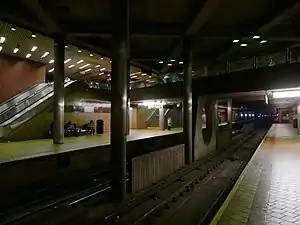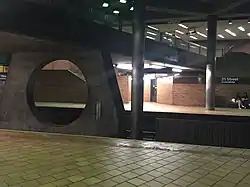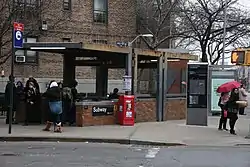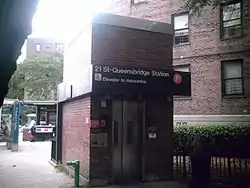21st Street–Queensbridge station
The 21st Street–Queensbridge station is a station on the IND 63rd Street Line of the New York City Subway. Located at the intersection of 21st Street and 41st Avenue within Queensbridge in Long Island City, Queens, it is served by the F shuttle train at all times except late nights.
21 Street–Queensbridge | |||||||||||||||||||||||||||||||||||||||||||||||||||||||||||||||||||||||||||||||||||||||||
|---|---|---|---|---|---|---|---|---|---|---|---|---|---|---|---|---|---|---|---|---|---|---|---|---|---|---|---|---|---|---|---|---|---|---|---|---|---|---|---|---|---|---|---|---|---|---|---|---|---|---|---|---|---|---|---|---|---|---|---|---|---|---|---|---|---|---|---|---|---|---|---|---|---|---|---|---|---|---|---|---|---|---|---|---|---|---|---|---|---|
 | |||||||||||||||||||||||||||||||||||||||||||||||||||||||||||||||||||||||||||||||||||||||||
| Station statistics | |||||||||||||||||||||||||||||||||||||||||||||||||||||||||||||||||||||||||||||||||||||||||
| Address | 21st Street & 41st Avenue Queens, NY 11101 | ||||||||||||||||||||||||||||||||||||||||||||||||||||||||||||||||||||||||||||||||||||||||
| Borough | Queens | ||||||||||||||||||||||||||||||||||||||||||||||||||||||||||||||||||||||||||||||||||||||||
| Locale | Queensbridge, Long Island City | ||||||||||||||||||||||||||||||||||||||||||||||||||||||||||||||||||||||||||||||||||||||||
| Coordinates | 40°45′15″N 73°56′33″W | ||||||||||||||||||||||||||||||||||||||||||||||||||||||||||||||||||||||||||||||||||||||||
| Division | B (IND)[1] | ||||||||||||||||||||||||||||||||||||||||||||||||||||||||||||||||||||||||||||||||||||||||
| Line | IND 63rd Street Line | ||||||||||||||||||||||||||||||||||||||||||||||||||||||||||||||||||||||||||||||||||||||||
| Services | F | ||||||||||||||||||||||||||||||||||||||||||||||||||||||||||||||||||||||||||||||||||||||||
| Transit | |||||||||||||||||||||||||||||||||||||||||||||||||||||||||||||||||||||||||||||||||||||||||
| Structure | Underground | ||||||||||||||||||||||||||||||||||||||||||||||||||||||||||||||||||||||||||||||||||||||||
| Platforms | 2 side platforms | ||||||||||||||||||||||||||||||||||||||||||||||||||||||||||||||||||||||||||||||||||||||||
| Tracks | 2 | ||||||||||||||||||||||||||||||||||||||||||||||||||||||||||||||||||||||||||||||||||||||||
| Other information | |||||||||||||||||||||||||||||||||||||||||||||||||||||||||||||||||||||||||||||||||||||||||
| Opened | October 29, 1989[2] | ||||||||||||||||||||||||||||||||||||||||||||||||||||||||||||||||||||||||||||||||||||||||
| Accessible | |||||||||||||||||||||||||||||||||||||||||||||||||||||||||||||||||||||||||||||||||||||||||
| Opposite- direction transfer | Yes | ||||||||||||||||||||||||||||||||||||||||||||||||||||||||||||||||||||||||||||||||||||||||
| Traffic | |||||||||||||||||||||||||||||||||||||||||||||||||||||||||||||||||||||||||||||||||||||||||
| 2019 | 3,516,992[3] | ||||||||||||||||||||||||||||||||||||||||||||||||||||||||||||||||||||||||||||||||||||||||
| Rank | 144 out of 424[3] | ||||||||||||||||||||||||||||||||||||||||||||||||||||||||||||||||||||||||||||||||||||||||
| |||||||||||||||||||||||||||||||||||||||||||||||||||||||||||||||||||||||||||||||||||||||||
| |||||||||||||||||||||||||||||||||||||||||||||||||||||||||||||||||||||||||||||||||||||||||
| |||||||||||||||||||||||||||||||||||||||||||||||||||||||||||||||||||||||||||||||||||||||||
| |||||||||||||||||||||||||||||||||||||||||||||||||||||||||||||||||||||||||||||||||||||||||
| |||||||||||||||||||||||||||||||||||||||||||||||||||||||||||||||||||||||||||||||||||||||||
| |||||||||||||||||||||||||||||||||||||||||||||||||||||||||||||||||||||||||||||||||||||||||
The station contains two tracks and two side platforms, connected by an overhead mezzanine. It opened in October 1989 with the opening of the 63rd Street Line. From its opening until 2001, this was the terminal of the line, although it was not originally intended as a terminal station. The 63rd Street Line was originally part of a plan for a Queens Bypass Line running along the Long Island Rail Road Main Line. However, due to a lack of funds, the line terminated here, with layup tracks going up to 29th Street. As a result, the tunnel became known as the "tunnel to nowhere."
In December 2001, the 63rd Street Tunnel Connection opened, allowing trains from the IND Queens Boulevard Line to use the line. This station then became a through station, serving express F trains since then.
History

The current 63rd Street Line was the final version of proposals for a northern midtown tunnel from the IND Queens Boulevard Line to the Second and Sixth Avenue lines, which date back to the IND Second System of the 1920s and 1930s.[4][5][6][7] The current plans were drawn up in the 1960s under the MTA's Program For Action,[8] where the 63rd Street subway line was to be built in the upper portion of the bi-level 63rd Street Tunnel.[9]: 5, 21 In the original 1960s plans, there would have been a station (in addition to or as an alternative to 21st Street–Queensbridge) located farther east at Northern Boulevard, one block north of the Queens Plaza station of the Queens Boulevard line. There would have been a pedestrian transfer passageway between the two stations.[10][11][12][13][14]
The station was placed at 21st Street, serving the Queensbridge Houses to the west, and commercial and industrial buildings to the east. The station was added to the plans following lobbying from the local community.[14][15][16] During construction, a large amount of disturbance was created along 41st Avenue, which runs through the heart of Queensbridge.[14]
The project faced extensive delays. As early as 1976, the Program for Action had been reduced to seven stations on the Archer Avenue and 63rd Street lines and was not projected to be complete for another decade.[17] By October 1980, officials considered stopping construction on the 63rd Street line.[18][19] Usage estimates for the 21st Street–Queensbridge station were calculated in 1984 at 220 passengers per hour unless a connection was made to the rest of the system.[20] The MTA voted in 1984 to connect the tunnel to the local tracks of the IND Queens Boulevard Line at a cost of $222 million. The section of the line up to Long Island City was projected to open by the end of 1985,[21] but flooding in the tunnel caused the opening to be delayed indefinitely.[22] The MTA's contractors concluded in February 1987 that the tunnel was structurally sound,[23] and the federal government's contractors affirmed this finding in June 1987.[24]
This station opened on October 29, 1989,[25] along with the entire IND 63rd Street Line, serving as the line's northern terminal prior to the connection with the IND Queens Boulevard Line.[2][26] The Q train served the station on rush hours and weekday middays, the B train stopped there on evenings and weekends, and the F terminated here during late nights; all services used the Sixth Avenue Line.[2] For the first couple of months after the station opened, the JFK Express to Kennedy Airport also served the station until it was discontinued on April 15, 1990.[27] The tunnel had gained notoriety as the "tunnel to nowhere" both during its planning and after its opening, with 21st Street being the line's only stop in Queens.[2][7] The connection to the Queens Boulevard Line began construction in 1994 and was completed and opened in 2001, almost thirty years after construction of the 63rd Street Tunnel began. Since then, the F train has been rerouted to serve this station at all times.[28]: 5 [29]: 2 [30][31][32]
The MTA completed a refurbishment of the station in May 2023. The project included repairing the platforms and stairways, adding lighting, fixing the canopy above the main entrance, and renovating employee rooms.[33][34] From August 28, 2023, through the first quarter of 2024, F trains are being rerouted via the 53rd Street Tunnel between Queens and Manhattan due to track replacement and other repairs in the 63rd Street Tunnel, and an F shuttle train runs between Lexington Avenue-63rd Street and 21st Street–Queensbridge at all times except late nights, stopping at Roosevelt Island.[35][36]
Station layout
| Ground | Street level | Exit/entrance |
| Basement 1 | Mezzanine | Fare control, station agent, MetroCard machines |
| Basement 2 Platform level |
Side platform | |
| Southbound | ← | |
| Northbound | ← (No service: Jackson Heights–Roosevelt Avenue except nights, 36th Street late nights) | |
| Side platform | ||
| Basement 3 East Side Access |
Track 1 | ← City Terminal Zone |
| Track 2 | City Terminal Zone → | |


The 21st Street–Queensbridge station has two tracks and two side platforms.[37][38] It is the eastern terminus of the F shuttle train, which runs between Lexington Avenue–63rd Street and 21st Street–Queensbridge at all times except nights.[39] In normal service, the F train serves the station at all times, while the ⟨F⟩ train serves the station northbound during AM rush hours and southbound during PM rush hours.[40] The next station to the north is Jackson Heights–Roosevelt Avenue during the day and 36th Street at night.[40] The next station to the south is Roosevelt Island.[41]
This underground station's only mezzanine is at the east end of station adjacent to the Manhattan-bound platform. Access to both platforms is via an overpass above the tracks, with staircases, escalators and elevators to platform level. At this point, the station has a high ceiling.[38] The platform walls as well as the floor are made of brick, and towards the top of the platform walls is a line of larger brown sheets, on these are the station signs at regular intervals that say "21 Street–Queensbridge." Above this is a thin black strip of metal and above this are yellow squares that take the platform walls up to the station ceiling that is made of concrete.[42] There are no columns between the two tracks or on the platforms, except near the mezzanine and overpass.[13][38]
As with other stations constructed as part of the Program for Action, the 21st Street–Queensbridge station contained technologically advanced features such as air-cooling, noise insulation, CCTV monitors, public announcement systems, electronic platform signage, and escalator and elevator entrances.[43]
Exits
Outside of fare control, the mezzanine leads to two street stairs at the northeast corner of 21st Street and 41st Avenue. An elevator and escalators are at the northwest corner of the same intersection.[16][38]
Track layout
Until the connection to the Queens Boulevard Line opened, this station shared the characteristic of a two side platformed terminal station with Flatbush Avenue–Brooklyn College on the IRT Nostrand Avenue Line. This is an inefficient terminal setup,[8] requiring passengers to know which track the next train will depart from before going to the platform level. As a terminal from 1989 to 2001, the station had tail tracks that continued eastward as far as 29th Street, ending at bumper blocks.[44][45][46] Also, this station has "punch boxes", with buttons to indicate route selection to the train dispatcher; a control tower on the west end of Manhattan-bound platform, which can be used if necessary; and a diamond crossover switch to the west which was used to turn trains.[47]
Stub tracks east of the station
East of the station, before the line connects to the IND Queens Boulevard Line, the tracks veer left while the tunnel wall goes straight, stopping around Northern Boulevard.[44][45][48][49][50][51] This bellmouth is part of an intended "super-express" bypass of the IND Queens Boulevard Line running along the mainline of the Long Island Rail Road between Queens Boulevard and Forest Hills–71st Avenue planned in 1968. At a proposed station at Northern Boulevard, for which the 29th Street tail tracks might have also been built, a transfer concourse to the Queens Plaza station would have allowed transfers between local, express, and bypass trains.[10][11][12][13][44][52][49]
The current bellmouth, built along with the Queens Boulevard connection, is two levels deep with two additional stub-end subway tracks named T1A and T2A.[51] It is viable for future construction of the bypass or the Northern Boulevard transfer station. The original bellmouth stopped at 29th Street.[45][51] The lower level of the bellmouth was excavated in 2003 for the LIRR East Side Access project, which also extended the subway stub tracks farther east towards Sunnyside Yard;[51][53][54][55] the lower-level tracks opened in 2023.[56] Just above the connection sits the 29th Street Ventilation Complex, built with the connector, in the site of a former parking lot.[45][48][49][51] West of the station, a second ventilation complex lies in Queensbridge Park between Vernon Boulevard and the East River.[51]
Ridership
In 2019, the station had 3,516,992 boardings, making it the 144th most used station in the 424-station system. This amounted to an average of 11,184 passengers per weekday.[3]
References
- "Glossary". Second Avenue Subway Supplemental Draft Environmental Impact Statement (SDEIS) (PDF). Vol. 1. Metropolitan Transportation Authority. March 4, 2003. pp. 1–2. Archived from the original (PDF) on February 26, 2021. Retrieved January 1, 2021.
- Lorch, Donatella (October 29, 1989). "The 'Subway to Nowhere' Now Goes Somewhere". The New York Times. p. 37. Archived from the original on August 17, 2020. Retrieved September 26, 2009.
- "Facts and Figures: Annual Subway Ridership 2014–2019". Metropolitan Transportation Authority. 2020. Retrieved May 26, 2020.
- Raskin, Joseph B. (2013). The Routes Not Taken: A Trip Through New York City's Unbuilt Subway System. New York, New York: Fordham University Press. doi:10.5422/fordham/9780823253692.001.0001. ISBN 978-0-82325-369-2.
- Roger P. Roess; Gene Sansone (August 23, 2012). The Wheels That Drove New York: A History of the New York City Transit System. Springer Science & Business Media. pp. 416–417. ISBN 978-3-642-30484-2.
- Board of Transportation of the City of New York (July 5, 1939). Project for Expanded Rapid Transit Facilities - New York City Transit System (Map). Archived from the original on March 6, 2023. Retrieved August 17, 2020.
- Knowles, Clayton (December 16, 1964). "Proposed Subway Tube Assailed As 'Nowhere‐to‐Nowhere' Link". The New York Times. p. 33. Archived from the original on August 17, 2020. Retrieved September 27, 2015.
- Metropolitan Commuter Transportation Authority (November 7, 1967). Metropolitan transportation, a program for action. Report to Nelson A. Rockefeller, Governor of New York (Report). New York. Retrieved October 1, 2015 – via Internet Archive.
- Dougherty, Peter (2020). Tracks of the New York City Subway 2020 (16th ed.). Dougherty. OCLC 1056711733.
- Burks, Edward C. (June 6, 1976). "Shortage of U.S. Funds May Delay Subway Link" (PDF). The New York Times. Retrieved September 27, 2015.
- Burks, Edward C. (July 29, 1976). "New Subway Line Delayed 5 or 6 Years" (PDF). The New York Times. Retrieved September 27, 2015.
- Burks, Edward C. (September 24, 1976). "Coming: Light at End of 63d St. Tunnel" (PDF). The New York Times. Archived from the original on October 5, 2022. Retrieved September 27, 2015.
- Burks, Edward C. (August 7, 1976). "New York Improving Subway, But Still Trails Foreign Cities" (PDF). The New York Times. Retrieved September 27, 2015.
- Lichtenstein, Grace (May 9, 1978). "Planned 40-Mile Queens Subway, Cut to 15, is Costly and Behind Time" (PDF). The New York Times. p. 68. Retrieved October 20, 2011.
- Daley, Suzanne (November 1, 1984). "63d St. Subway Tunnel: More Setbacks for a Troubled Project". The New York Times. p. B1. Archived from the original on October 10, 2020. Retrieved September 27, 2015.
- "MTA Neighborhood Maps: Long Island City" (PDF). Metropolitan Transportation Authority. 2015. Archived (PDF) from the original on June 5, 2020. Retrieved September 27, 2015.
- Burks, Edward C. (July 29, 1976). "New Subway Line Delayed 5 or 6 Years" (PDF). The New York Times. p. 35. Retrieved October 20, 2011.
- Andelman, David A. (October 11, 1980). "Tunnel Project, Five Years Old, Won't Be Used" (PDF). The New York Times. p. 25. Retrieved October 20, 2011.
- "New York City Transit 63rd Street-Queens Boulevard Connection-New York City – Advancing Mobility – Research – CMAQ – Air Quality – Environment – FHWA". fhwa.dot.gov. Archived from the original on August 8, 2016. Retrieved July 3, 2016.
- Queens Subway Options Study, New York: Environmental Impact Statement. United States Department of Transportation, Metropolitan Transportation Authority, Urban Mass Transit Administration. May 1984. p. 83. Retrieved July 10, 2016.
- Daley, Suzanne (December 15, 1984). "M.T.A. Votes to Extend 63rd St. Line". The New York Times. ISSN 0362-4331. Archived from the original on February 3, 2018. Retrieved February 2, 2018.
- Daley, Suzanne (June 28, 1985). "63d St. Subway Tunnel Flawed; Opening Delayed". The New York Times. p. 1. Archived from the original on May 24, 2015. Retrieved October 20, 2011.
- Levine, Richard (February 7, 1987). "M.T.A. Proposes Opening 63d Street Tunnel in '89". The New York Times. Archived from the original on March 25, 2020. Retrieved October 20, 2011.
- Connelly, Mary; Douglas, Carlyle C. (June 28, 1987). "New Money Gives 63d Street Tunnel Somewhere To Go". The New York Times. Archived from the original on December 6, 2010. Retrieved October 20, 2011.
- "63 St Subway Extension Opened 25 Years Ago this Week". mta.info. Metropolitan Transportation Authority. October 31, 2014. Archived from the original on August 17, 2020. Retrieved July 28, 2016.
- Kershaw, Sarah (December 17, 2001). "V Train Begins Service Today, Giving Queens Commuters Another Option". The New York Times. p. F1. Archived from the original on August 17, 2020. Retrieved October 16, 2011.
- Grynbaum, Michael M. (November 25, 2009). "If You Took the Train to the Plane, Sing the Jingle". The New York Times. Archived from the original on July 21, 2020. Retrieved July 3, 2016.
- Review of F Line Operations, Ridership, and Infrastructure (PDF). nysenate.gov (Report). MTA New York City Transit Authority. October 7, 2009. Archived from the original (PDF) on May 31, 2010. Retrieved July 28, 2015.
- Review of the G Line (PDF). mta.info (Report). Metropolitan Transportation Authority. July 10, 2013. Archived from the original (PDF) on December 24, 2019. Retrieved August 2, 2015.
- O'Neill, Natalie (April 13, 2012). "History shows it's not the G train 'extension' — it's the G train renewal". The Brooklyn Paper. Archived from the original on August 17, 2020. Retrieved August 2, 2015.
- "E, F Detour in 2001, F trains via 63 St, E no trains running, take R instead". The Subway Nut. Archived from the original on March 2, 2011. Retrieved October 20, 2011.
- Kennedy, Randy (May 25, 2001). "Panel Approves New V Train but Shortens G Line to Make Room". The New York Times. p. B6. Archived from the original on August 17, 2020. Retrieved March 20, 2010.
- "NYMTA Completes Renovation of Queensbridge Station". Railway Track and Structures. May 3, 2023. Archived from the original on May 8, 2023. Retrieved May 8, 2023.
- "MTA advances NYCT subway station rebuild project". Progressive Railroading. May 2, 2023. Retrieved May 9, 2023.
- "Service changes on the F and M lines starting August 28". MTA. Retrieved July 30, 2023.
- "F, M changes start Monday: What to know about the subway interruptions lasting until 2024". NBC New York. August 25, 2023. Retrieved August 26, 2023.
- Dougherty, Peter (2020). Tracks of the New York City Subway 2020 (16th ed.). Dougherty. OCLC 1056711733.
- Silvercup West FEIS: 10.0 Transit and Pedestrians (PDF). nyc.gov (Report). New York City Department of City Planning. June 30, 2006. Archived (PDF) from the original on August 17, 2020. Retrieved August 15, 2016.
- "F SHUTTLE Subway Timetable, Effective August 28, 2023". Metropolitan Transportation Authority. Retrieved August 26, 2023.
- "F Subway Timetable, Effective August 28, 2023". Metropolitan Transportation Authority. Retrieved August 26, 2023.
- "Subway Map" (PDF). Metropolitan Transportation Authority. September 2021. Retrieved September 17, 2021.
- Cox, Jeremiah. "21 St-Queensbridge (F) – The SubwayNut". subwaynut.com. Archived from the original on July 6, 2020. Retrieved August 15, 2016.
- Burks, Edward C. (August 7, 1976). "New York Improving Subways, But Still Trails Foreign Cities". The New York Times. ISSN 0362-4331. Archived from the original on July 14, 2022. Retrieved July 14, 2022.
- Queens Subway Options Study, New York: Environmental Impact Statement. United States Department of Transportation, Metropolitan Transportation Authority, Urban Mass Transit Administration. May 1984. pp. 83–. Retrieved July 10, 2016.
- Final Environmental Impact Statement for the 63rd Street Line Connection to the Queens Boulevard Line. Queens, New York, New York: Metropolitan Transportation Authority, United States Department of Transportation, Federal Transit Administration. 1992. Retrieved July 23, 2016.
- "Playing in the Neighborhood: Long Island City; Tortoise Heads into Queens". The New York Times. October 18, 1998. p. 15. Archived from the original on August 17, 2020. Retrieved September 27, 2015.
- Marrero, Robert (January 1, 2017). "472 Stations, 850 Miles" (PDF). B24 Blog, via Dropbox. Retrieved April 27, 2018.
- "MTA 63rd Street Connector". Metropolitan Transportation Authority. Archived from the original on October 30, 2014. Retrieved October 1, 2015.
- Silano, Louis G.; Shanbhag, Radmas (July 2000). "The Final Connection". Civil Engineering. 70 (7): 56–61. eISSN 2381-0688. ISSN 0885-7024. ProQuest 228460673.
- Caitsith810 (December 17, 2008). "Railfan Window of an R32 F Train From 57th Street to 36th Street, Queens Part Two (The bellmouth for the intended super-express bypass can be seen towards the right, at the 3:09 mark into the video.)". Archived from the original on November 14, 2021. Retrieved October 4, 2010 – via YouTube.
- East Side Access in New York, Queens, and Bronx Counties, New York, and Nassau and Suffolk Counties, New York: Environmental Impact Statement. Metropolitan Transportation Authority, United States Department of Transportation, Federal Transit Administration. March 2001. Retrieved July 23, 2016.
- Erlitz, Jeffrey (February 2005). "Tech Talk". New York Division Bulletin. Electric Railroaders Association. 48 (2): 9–11. Archived from the original on August 16, 2016. Retrieved July 10, 2016.
- Nasri, V.; Lee, W.S.; Rice, J. (2004). "Comparison of the predicted behavior of the Manhattan TBM launch shaft with the observed data, East Side Access Project, New York". North American Tunneling. Taylor & Francis: 537–544. ISBN 9781439833759. Retrieved July 23, 2016.
- Reed, Mary (January 16, 2009). "Tunnel Boring Machines Core Under Big Apple's East River". ConstructionEquipmentGuide.com. Archived from the original on August 17, 2020. Retrieved July 23, 2016.
- Metropolitan Transportation Authority (January 24, 2012). East Side Access – 1/24/2012 Update (video). Archived from the original on November 14, 2021 – via YouTube.
- Ley, Ana (January 25, 2023). "L.I.R.R. Service to Grand Central Begins Today at Long Last". The New York Times. ISSN 0362-4331. Archived from the original on January 25, 2023. Retrieved January 25, 2023.


